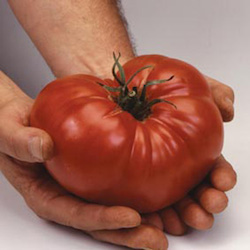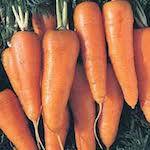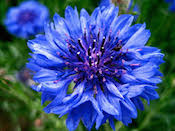Nostalgia in the Garden
By: Charleen Barr
Colorado State University Extension Master Gardener in Larimer County
Planting seeds has been a human activity for thousands of years. Seed was saved and replanted again the following year. Over several generations, plants were selected for certain traits. Our edible broccoli, for example, became different from the tough, wild plants that are its ancestor.
The scientific definition of an heirloom is an open-pollinated variety—meaning the flower is pollinated by insects, hummingbirds or wind with pollen from another plant to create fruit true-to-type. Growers can save seed from their crop and sow again in following years and the plants will produce fruit with the same characteristics and quality of the parent. The seeds are often passed down so they become ‘heirlooms’.
Today, heirlooms are considered as those seeds that have been around for over 50 years. Seeds create a legacy. Heirloom gardening enables us to collect a part of history that represents valued possessions and cultural differences.
What is commonly understood is that heirloom varieties have a history, have been kept in a family or achieved a measure of local or regional fame. Many types of seeds are immigrants—cherished varieties that can be specifically tied to a group of people and were brought to America by early settlers. The preservation of these seeds was not particularly sentimental, but they became time-tested varieties that found approval. Think of an heirloom seed like a family heirloom passed down from generation to generation.
Some gardeners focus on varieties before the 1920s, and others re–create World War II Victory Gardens with introductions from the 1920s, 30s and early 40s. Many varieties are up to 150 years old and some are traditional Native American crops that are pre-Columbian. Others are old European crops in cultivation for over 400 years.
 Heirloom vegetables, fruits, flowers and herbs are varieties that are open-pollinated represent a vast and diverse pool of genetic characteristics. They have remained popular with home gardeners because they grow well and have depth of flavor. They do not keep well during shipping or storage and many of them do not have consistent appearance. The harvest of heirloom vegetables are spread over a longer period of time rather than bumper crops all at one time.
Heirloom vegetables, fruits, flowers and herbs are varieties that are open-pollinated represent a vast and diverse pool of genetic characteristics. They have remained popular with home gardeners because they grow well and have depth of flavor. They do not keep well during shipping or storage and many of them do not have consistent appearance. The harvest of heirloom vegetables are spread over a longer period of time rather than bumper crops all at one time.
Some heirlooms may be less productive in quantity, but they are adaptable to their environment within two to three growing seasons. During this time period they show better vigor, production, flavor and an increase in disease resistance. They offer a wide range of shapes, colors and tastes unavailable in modern cultivars.
Famous easy heirlooms to grow:
- ‘Brandywine’ tomato (1886 – originally may have been named ‘Turner’s Hybrid’ and renamed ‘Brandywine’ in 1889)
 ‘Early Horn’ or ‘Early Scarlet Horn’ carrots (1620 – one of the oldest vegetable varieties still in cultivation)
‘Early Horn’ or ‘Early Scarlet Horn’ carrots (1620 – one of the oldest vegetable varieties still in cultivation)
- ‘French Breakfast’ radish (1885 – a favorite of French market gardeners)
- ‘Hubbard’, ‘Blue Hubbard’ and ‘Warted Hubbard’ squash (1798 in the West Indies – In 1842 Mrs. Elizabeth Hubbard of Massachusetts brought the squash seeds to a neighbor James Gregory who named the variety for her.)
- ‘Jenny Lind’ Melon (1845 – served as parent of numerous popular varieties)
- ‘Kentucky Wonder’ beans (1864 – Originally named Old Homestead)
- ‘Paris White Cos’ lettuce (1835 – initially grown in Europe, made its way to US in 1864)
- “Early Jersey Wakefield” cabbage (1840 – originally named early Wakefield. Julius Caesar’s troops carried cabbage with them to Britain when they invaded in 55 B.C. In 1541 cabbages made their way into Canada with the French explorer Jacques Cartier. The plant became a food staple for Jamestown and Williamsburg settlers.)
- Hollyhocks (Althea rosea) were a common plant in colonial gardens. They are associated with farmsteads and common outbuildings with the unflattering name of “outhouse” flower. These flowers helped the ladies of the 19th century discover the location of the outhouse by just looking for the hollyhocks.
 Cornflowers or bachelor buttons are perfect for Front Range soils, drought tolerant and informal gardens.
Cornflowers or bachelor buttons are perfect for Front Range soils, drought tolerant and informal gardens.
- Cosmos were introduced to Britain from their native Mexico in 1799. It is often referred to as the Mexican aster.
- Golden Bantam’ corn (1902 – first yellow “table” corn; yellow was considered field corn)
- Larkspur is native to southern Europe and Mediterranean area and was introduced to America in 1572.
- Morning glory (Ipomoea purpurea) were from Italy and Spain and the British in 1651.
- Nasturtiums have a culinary history and eaten in the 17th and 18th century as vegetables.
- Pinks are the common name for Dianthus barbatus. There are more than 300 varieties that have been cultivated for at least 2,000 years.
- Sweet peas have been available commercially since 1714 and cultivated in England and Holland.
Additional seed and seed history information:
Seed Savers Exchange, 3094 North Winn Road, Decorah, Iowa 52101, (513)354-1492, www.seedsavers.org.
Baker Creek Heirloom Seeds, 2278 Baker Creek Road, Mansfield, MO 65704, (417)924-8917 www.bountifulgardens.org.
Seeds of Change 1 Sunset Way, Henderson, NV. 89014, (888)762-7333 www.seedsofchange.com
Thomas Jefferson Center for Historic Plants, P.O. Box 316, Charlottesville, VA 22902, www.monticello.org
Plants of the Southwest 3095 Aqua Fria Road, Santa Fe, NM 87507 (800)788-7333 www.plantsofthesouthwest.com
Gardening Tips
By: Loni Gaudet
Colorado State University Extension Master Gardener in Larimer County
With the cool wet spring Colorado has experienced this year comes issues that gardeners don’t often see. There are several ways in which water and humidity contribute to these problems:
- Moisture activates bacterial, fungal and nematode pathogens that can infect plants;
- Splashing or running water spreads fungal spores and bacterial ooze plant-to-plant or to different locations on the same plant. Water efficiently transports pathogens, and wet leaf surfaces provide ideal environments for infection.
- Abundant water increases the succulence of plants (new, tender growth), making them more susceptible to pathogens. High concentrations of water in plant tissues especially favor bacteria.
- Cool wet soils make it difficult for several plants to absorb iron through their roots.
There is also a human component – enthusiastic gardeners or those with spring fever go out in the garden every time the sun peeks out, causing soil compaction. When we step in, or work, soil that is wet, we cause much greater compaction than usual. This reduces the amount of oxygen between soil particles which is needed for healthy root growth.
To care for your plants during a cool wet spring, try the following:
- Avoid walking through your garden – stay on designated paths.
- Avoid digging or working wet soil.
- Adjust your irrigation system or install a rain/moisture detector so that you aren’t watering already saturated soils.
- Decrease leaf infections through careful plant thinning and pruning to allow drying air to move around and through plants. Be sure you’re pruning at the right time of year for that particular plant.
- If you are pruning, sanitize your pruning tools between plants, and if you’re pruning a plant with a known disease, sanitize between every cut (using isopropyl alcohol or bleach).
And finally, remember, the sun will come out!
Gardening Q&As
By: Sally Weisser
Colorado State University Extension Master Gardener in Larimer County
Q: Obviously rain in Colorado is a good thing, but it seems we’ve had more than enough lately. What does this mean for our gardens?
A: The cold, wet spring that we have been experiencing this year has been a challenge for even the most experienced gardener. It has been too cool and wet for planting pretty much everything. Soil should never be worked or dug when wet because it will cause compaction, clods, and large hard soil clumps that will have the consistency of concrete as it dries. Our clay soil in Northern Colorado needs amendments to improve porosity, aeration, and drainage, but amendment of soil should not be done while soil is wet. We need a string of warm, dry days so that our soil can be worked. Wet soil can be cold and warm weather vegetables need warm soil (above 65 degrees) to thrive. Raised beds and containers will dry out before ground soil and can be worked first. If you pick up a handful of soil and it forms into a solid ball, then it is too wet to work. Dry soil will be flakey and easily crumble in your fingers.
It will probably be better this growing season to choose vegetable plants and seeds that have a ninety day or less maturity rate to avoid an early fall killing frost. Early maturing tomatoes will likely give you the greatest yield this summer. Tomatoes do not start to thrive until nighttime temperatures are above 50 degrees and should not be planted into the ground until the sun comes out and temperatures improve.
When the weather does warm and dry out, be patient with your landscape. Allow lawns to dry before you consider turning on your sprinkler system or plan aeration. Give roses and perennials a bit of fertilizer to promote new growth. Cut back dead stems and leaves and consider applying a new layer of mulch to your plants and shrubs to help them prepare for the hot summer. Remove and replace dead trees, shrubs, and perennials after you have given them a sufficient amount of time to revive.
The authors have received training through Colorado State University Extension’s Master Gardener program and are Master Gardener volunteers for Larimer County.
Larimer County is a county-based outreach of Colorado State University Extension providing information you can trust to deal with current issues in agriculture, horticulture, nutrition and food safety, 4-H, small acreage, money management and parenting. For more information about CSU Extension in Larimer County, call (970) 498-6000 or visit www.larimer.org/ext
Looking for additional gardening information? Check out the CSU Extension Horticulture Agent blog at www.csuhort.blogspot.com for timely updates about gardening around the state.
Visit PlantTalk Colorado ™ for fast answers to your gardening questions! www.planttalk.org PlantTalk is a cooperation between Colorado State University Extension, GreenCo and Denver Botanic Gardens.